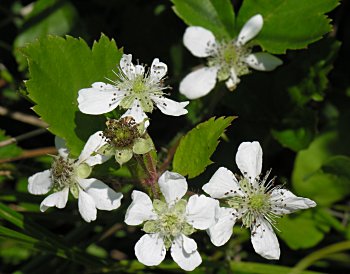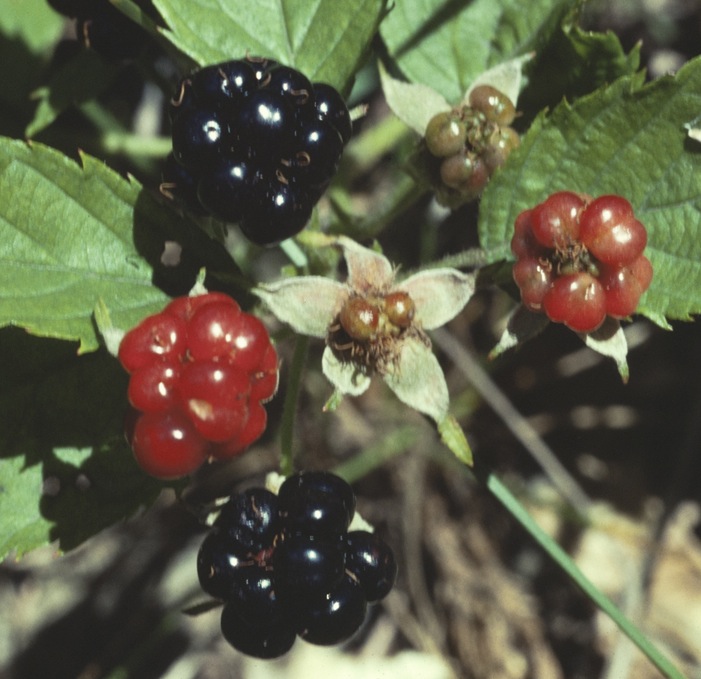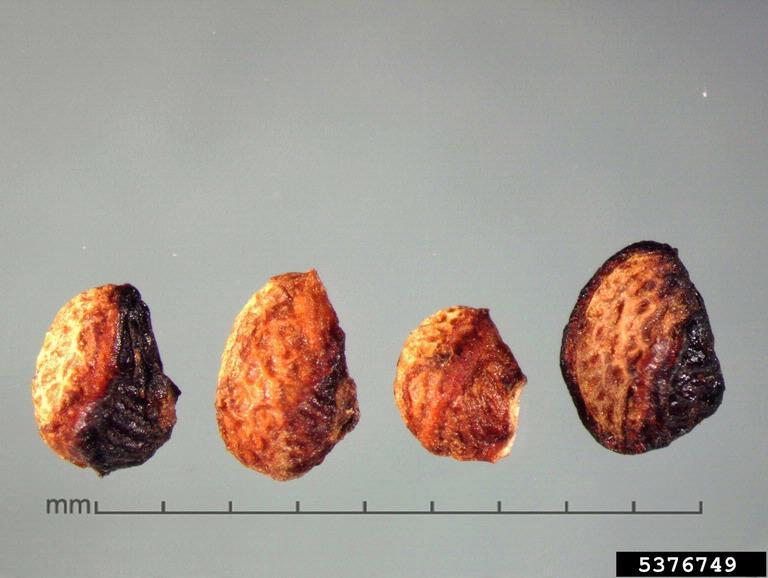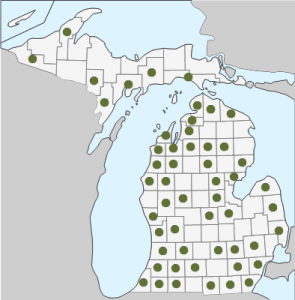 Download PDF
Download PDF
Name: Rubus hispidus L.
Family: Rosaceae, the Rose family (2)
Common Names: Running Swamp Blackberry (1), Dewberry (3), Bristly Blackberry (6), Swamp Dewberry, Bristly Dewberry (7), Northern Dewberry (8)
 Etymology: “Rubus” means blackberry and the latin word hispidus means hispid, or bristly (4,12).
Etymology: “Rubus” means blackberry and the latin word hispidus means hispid, or bristly (4,12).
Botanical synonyms (6, 11,13):
R. obovalis Michaux
R. obovatus Pers.
R. sempervirens BIgelow
Quick Notable Features:
¬ Trailing scrambler
¬ White flowers and black berries
¬ Dense bristles
¬ 3-5 dark green, toothed leaflets
Plant Height: can grow up to 2.5m (2).
 Subspecies/varieties recognized (7):
Subspecies/varieties recognized (7):
R. hispidus var. obovalis
R. hispidus var. blanchardianus
R. hispidus var. cupulifer
R. hispidus var. hispidus
R. hispidus var. major
R. hispidus var. pervarius
R. hispidus var. setosus
R. hispidus var. suberectus
R. hispidus subsp. continentalis
Most Likely Confused with: R. flagellaris, R. setosus, R. trivialis, R. allegheniensis, R. caesius, R. arundelanus, R. orarius, R. cuneifolius, R. argutus, Rosa eglanteria, and Rosa setigera (3, 5, 20).
Habitat Preference: R. hispidus prefers moist and open habitats; it thrives in disturbed sites as a pioneer species, but it is able to persist to later stages of succession (2,5,8).
Geographic Distribution in Michigan: R. hispidus is found in most counties in the Lower Peninsula as well as most southern Upper Peninsula counties (13).
Known Elevational Distribution: The species occurs up to 980m altitude in West Virginia (19).
Complete Geographic Distribution: R. hispidus is found in Canada (NB, NF, NS, ON, PE, QC) and in the midwest and eastern United States (CT, DC, DE, IA, IL, IN, KS, KY, LA, MA, MD, ME, MI, NC, NH, NJ, NY, OH, PA, RI, SC, TN, VA, VT, WI, WV) (7,8,13).
Vegetative Plant Description: The trailing pubescent stems (terete or angled) grow up to 2.5m. The primocanes of this species are intensely bristly with up to 200 bristles and glands per centimeter on the stem. Even the petioles of primocane leaves have hundreds of bristles, although the floricanes are less bristly. Stems often root at the tips. Leaves are pinnately compound and alternate, with 3-5 leaflets. The evergreen, coriaceous leaflets are pubescent below, serrate, obovate, acuminate, and range from 2 to 6cm long and 1 to 4cm wide (1, 2, 21).
Climbing Mechanism: trailing, using the fine bristles for adhering to host (2, RJB pers. obs.).
 Flower Description: The inflorescence is a cyme of small white-petaled flowers. Each flower bears 3-7 sepals (3-5mm) that are oblanceolate and hairy, 5 petals (5-9mm long, 2-5mm wide), and stamens and carpels that are numerous. Styles are terminal on each carpel. Dewberries have two ovules per pistil (usually between 20-40 pistils per flower), which will mature into the seeds (2,6,21,23).
Flower Description: The inflorescence is a cyme of small white-petaled flowers. Each flower bears 3-7 sepals (3-5mm) that are oblanceolate and hairy, 5 petals (5-9mm long, 2-5mm wide), and stamens and carpels that are numerous. Styles are terminal on each carpel. Dewberries have two ovules per pistil (usually between 20-40 pistils per flower), which will mature into the seeds (2,6,21,23).
Flowering Time: Flowers from June through early September in the Central and Northeastern United States and adjacent Canada (2).
Pollinator: insects, including honeybees (9,23).
 Fruit Type and Description: R. hispidus matures the black fruits from mid August to October. The fruit type is an aggregate of drupelets (75-85) that turn from green to red to black as the fruit matures (2,8, 23). Birds disperse the fruits, as well as the casual hiker.
Fruit Type and Description: R. hispidus matures the black fruits from mid August to October. The fruit type is an aggregate of drupelets (75-85) that turn from green to red to black as the fruit matures (2,8, 23). Birds disperse the fruits, as well as the casual hiker.
Seed Description: The small seeds are bird dispersed, high in sugar, low in lipids, and usually are not retained on the plant for long. The seed requires cold stratification for germination (16, 17).
Dispersal Syndrome: R. hispidus reproduces sexually if visited by insect pollinators, and birds often disperse the seeds, but it also engages in vegetative reproduction through clonal expansion. A study by Abrahamson (1975) indicates that sexual reproduction is preferred when the plant is growing in dense woods, while vegetative reproduction is preferred in open areas (8,9,10,16).
 Distinguished by: Rubus hispidus var. hispidus can be differentiated from R. hispidus var. obovalis by the thickness of the stems, the number of bristles, and the size of terminal leaflets. R. hispidus var. hispidus stems are 2-5mm thick, with 30-200 bristles per cm and a terminal leaflet 2.5-7 cm. long and 2-5.5 cm. wide. R. hispidus var. obovalis stems are thinner, measuring only 1-2mm thick, with 1-20 bristles per cm. and a smaller terminal leaflet measuring 1.5-4.5 cm. long and 1-3.5 cm. wide. Compared to R. flagellaris, R. hispidus bristles are thinner and longer, not often with broad bases like the shorter bristles on R. flagellaris. The inflorescence in R. flagellaris, and especially R. setosus, are very likely to be glandular while R. hispidus rarely show this trait. The flatter-topped inflorescence in R. setosus is another distinctive trait, and even though the bristles are very similar to R. hispidus, the erect stems do not root at the tips as in R. hispidus, whose stems trail and root. R. trivialis has glandular bristles and single flowers while R. hispidus bristles are eglandular and flowers are aggregated. R. allegheniensis is also distinguished by the erect primocane with broad-based spines. R. caesius has spines, but not bristles. Rosa eglanteria’s leaves have odor, the thorns have a large base and slightly more leaflets than R. hispidus, which is not fragrant and has fine bristles. Rosa setigera bears red receptacle-derived fruits (hips), broad-based curved thorns, and pink flowers, while R. hispidus’ fruits are black drupelets and its flowers are white (2,3,5,20,21).
Distinguished by: Rubus hispidus var. hispidus can be differentiated from R. hispidus var. obovalis by the thickness of the stems, the number of bristles, and the size of terminal leaflets. R. hispidus var. hispidus stems are 2-5mm thick, with 30-200 bristles per cm and a terminal leaflet 2.5-7 cm. long and 2-5.5 cm. wide. R. hispidus var. obovalis stems are thinner, measuring only 1-2mm thick, with 1-20 bristles per cm. and a smaller terminal leaflet measuring 1.5-4.5 cm. long and 1-3.5 cm. wide. Compared to R. flagellaris, R. hispidus bristles are thinner and longer, not often with broad bases like the shorter bristles on R. flagellaris. The inflorescence in R. flagellaris, and especially R. setosus, are very likely to be glandular while R. hispidus rarely show this trait. The flatter-topped inflorescence in R. setosus is another distinctive trait, and even though the bristles are very similar to R. hispidus, the erect stems do not root at the tips as in R. hispidus, whose stems trail and root. R. trivialis has glandular bristles and single flowers while R. hispidus bristles are eglandular and flowers are aggregated. R. allegheniensis is also distinguished by the erect primocane with broad-based spines. R. caesius has spines, but not bristles. Rosa eglanteria’s leaves have odor, the thorns have a large base and slightly more leaflets than R. hispidus, which is not fragrant and has fine bristles. Rosa setigera bears red receptacle-derived fruits (hips), broad-based curved thorns, and pink flowers, while R. hispidus’ fruits are black drupelets and its flowers are white (2,3,5,20,21).
Other members of Michigan Rosaceae (# species): Rubus (48), Crataegus (42), Rosa (18), Prunus (16), Potentilla (11), Geum (9), Amelanchier (6), Spiraea (6), Agrimony (5), Malus (4), Sanguisorba (3), Sorbus (3), Physocarpus (2), Fragaria (2), Gillenia (2), Photinia (2), Argentina (1), Aruncus (1), Chamaerhodos (1), Comarum (1), Dalibarda (1), Dasiphorda (1), Duchesnea (1), Filipendula (1), Pyrus (1), Sibbaldiopsis (1), Sorbaria (1), Waldsteinia (1) (ref. 20).
Ethnobotanical Uses: Native Americans used the roots to treat cough, fever, and diarrhea. The fruits were used to treat dysentery (14, 15).
 Phylogenetic Information: The genus Rubus is classified as member of the subfamily Rosoideae in the Rosaceae, which is in the order Rosales, a Eudicot clade of the angiosperms. Members of the Rosaceae family can be found worldwide, and the genus Rubus is found in both north and south temperate climatic zones (18, 22).
Phylogenetic Information: The genus Rubus is classified as member of the subfamily Rosoideae in the Rosaceae, which is in the order Rosales, a Eudicot clade of the angiosperms. Members of the Rosaceae family can be found worldwide, and the genus Rubus is found in both north and south temperate climatic zones (18, 22).
Interesting Quotation or Other Interesting Factoid not inserted above: Hybrids derived from a cross between R. hispidus and other Rubus species, such as R. setosus, are found in Michigan: R. distinctus, R. kalamazoensis, R. plus, and R. signatus (20).
Literature and websites used:
- Parkhurst, H.E. 1903. Trees, shrubs and vines of the northeastern United States. New York, New York, USA: C. Scribner’s Sons.
- Fernald, M.L. 1950. Gray’s Manual of Botany, 8th ed. New York, USA: American Book Co.
- Gleason, H.A. 1963. Illustrated Flora of the Northeastern United States and Adjacent Canada, Volume 2. New York, New York, USA: Hafner Publishing Company, Inc.
- Bailey, H.L. 1963. How Plants Get Their Names. New York, New York, USA: Dover Publications, Inc.
- Braun, E.L. 1967. The Woody Plants of Ohio: Trees, shrubs, and woody climbers, native, naturalized, and escaped. Columbus, Ohio, USA; The Ohio State University Press.
- Wood A.M. 1854. A Class-Book of Botany. Manufacturing Company, Claremont, NH, USA.
- Tropicos.org. Missouri Botanical Garden. (http://www.tropicos.org/Name/27801261, 08 Oct 2010). Saint Louis, Missouri 63110 USA.
- Abrahamson, W.G. 1975. Reproduction of Rubus hispidus L. in different habitats. American Midland Naturalist 93(2):471-478.
- Nybon, H. 1987. Pollen-limited seed set in pseudogamous blackberries (Rubus L. subgen. Rubus). Oecologia 72(4): 562-568.
- Abrahamson, W.G. 1975. Reproductive strategies in dewberries. Ecology 56(3): 721-726.
- Davis, H.A. 1990. Studies in Rubus. Castanea 55(1):22-30.
- Brown, R.W. 1956. Composition of Scientific Words. Washington, D.C., USA: Smithsonian Institution Press.
- Wisconsin State Herbarium. (http://www.botany.wisc.edu/cgi-bin/detail.cgi?SpCode=RUBHIS&Genus=Rubus&Family=Rosaceae&Species=hispidus&Common=bristly%20dewberry%2C%20swamp%20dewberry&photo=..%2Fphotos%2FRUBHIS_KS1.jpg&thumbmaps=..%2Fthumbmap%2FRUBHIS.gif&hand=, 08 Oct 2010).
- Chandlera, R.F., L. Freeman, and S.N. Hooper 1979. Herbal remedies of the maritime Indians. Journal of Ethnopharmacology 1: 49-68.
- Carr, L.G. and C. Westley 1945. Surviving folktales and herbal lore among the Shinnecock Indians of Long Island. Journal of American Folklore 58(228): 113-123.
- Stiles, E.W. 1980. Patterns of fruit presentation and seed dispersal in bird-disseminated woody plants in the eastern deciduous forest. The American Naturalist 116(5): 670-688.
- The PLANTS Database: USDA, NRCS, 1991-2007. http://plants.usda.gov/java/profile?symbol=RUHI
- Judd, W.S., C.S. Campbell, E.A. Kellogg and P.F. Stevens. 1999. Plant Systematics: A Phylogenetic Approach. Sunderland, Massachusetts, USA: Sinauer Associates, Inc.
- Wieder, R.K., C.A. Bennett, and G.E. Lang 1981. Vegetational analysis of Big Run Bog, a nonglaciated Sphagnum bog in West Virginia. Castanea 46(1): 16-29.
- Voss, E.G. 1985. Michigan Flora Part II: Dicots. Ann Arbor, Michigan, USA: Cranbrook Institute of Science.
- Radford, A.E., H.E. Ahles, and C.R. Bell. 1968. Manual of the Vascular Flora of the Carolinas. Chapel Hill, North Carolina, USA: The University of North Carolina Press.
- Stevens, P.F. Angiosperm Phylogeny Website. Version 9 June 2008. http://www.mobot.org/mobot/research/apweb.
- Sandler, H.A. 2001. Dewberries and Brambles, Rubus spp.. University of Massachusetts, Cranberry Experiment Station. Downloaded October 28, 2010 from http://www.umass.edu/cranberry/pubs/factsheets.html
Image Credits (all used with permission):
1) Habit image of Rubus hispidus courtesy of Cofrin Center for Biodiversity, Gary Fewles photographer, http://www.uwgb.edu/biodiversity/herbarium/shrubs/rubhis_aspect01.jpg
2, 3) Image of leaves and flower courtesy of Will Cook from the website “Trees, Shrubs, and Woody Vines of North Carolina” at http://www.duke.edu/~cwcook/trees/ruhi.html
4) Fruit image courtesy of K.J. Sytsma, Wisconsin State Herbarium, photo taken in Kalamazoo Michigan during his master’s thesis at Western Michigan University http://www.botany.wisc.edu/wisflora/
5) Image of seeds courtesy of Julia Scher, USDA APHIS PPQ, Bugwood.org http://www.forestryimages.org/browse/detail.cfm?imgnum=5376749
6) Species distribution map, derived from the Michigan Flora Online.
Primary Authors: Cristine Santanna with editing by John Bradtke and Robyn J. Burnham
© Robyn J. Burnham, University of Michigan
For additional information on Michigan Plant Diversity web pages please contact Robyn J. Burnham via email: rburnham“at”umich.edu